脑出血病例讨论
- 格式:ppt
- 大小:2.85 MB
- 文档页数:40
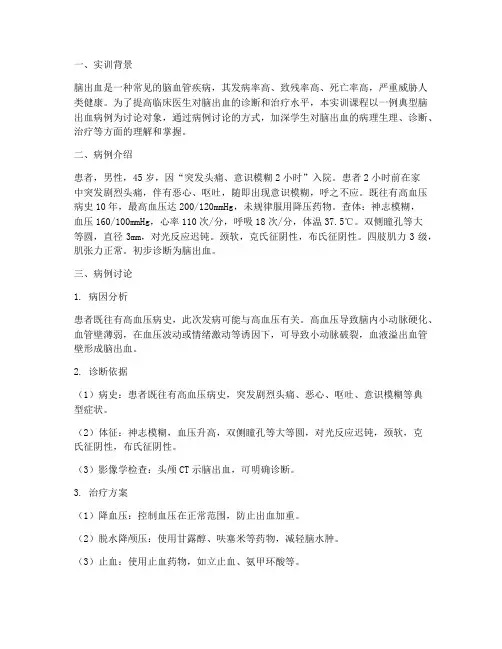
一、实训背景脑出血是一种常见的脑血管疾病,其发病率高、致残率高、死亡率高,严重威胁人类健康。
为了提高临床医生对脑出血的诊断和治疗水平,本实训课程以一例典型脑出血病例为讨论对象,通过病例讨论的方式,加深学生对脑出血的病理生理、诊断、治疗等方面的理解和掌握。
二、病例介绍患者,男性,45岁,因“突发头痛、意识模糊2小时”入院。
患者2小时前在家中突发剧烈头痛,伴有恶心、呕吐,随即出现意识模糊,呼之不应。
既往有高血压病史10年,最高血压达200/120mmHg,未规律服用降压药物。
查体:神志模糊,血压160/100mmHg,心率110次/分,呼吸18次/分,体温37.5℃。
双侧瞳孔等大等圆,直径3mm,对光反应迟钝。
颈软,克氏征阴性,布氏征阴性。
四肢肌力3级,肌张力正常。
初步诊断为脑出血。
三、病例讨论1. 病因分析患者既往有高血压病史,此次发病可能与高血压有关。
高血压导致脑内小动脉硬化、血管壁薄弱,在血压波动或情绪激动等诱因下,可导致小动脉破裂,血液溢出血管壁形成脑出血。
2. 诊断依据(1)病史:患者既往有高血压病史,突发剧烈头痛、恶心、呕吐、意识模糊等典型症状。
(2)体征:神志模糊,血压升高,双侧瞳孔等大等圆,对光反应迟钝,颈软,克氏征阴性,布氏征阴性。
(3)影像学检查:头颅CT示脑出血,可明确诊断。
3. 治疗方案(1)降血压:控制血压在正常范围,防止出血加重。
(2)脱水降颅压:使用甘露醇、呋塞米等药物,减轻脑水肿。
(3)止血:使用止血药物,如立止血、氨甲环酸等。
(4)营养支持:保证营养供应,促进患者恢复。
(5)康复治疗:病情稳定后,进行康复训练,提高患者生活质量。
四、实训总结通过本次病例讨论实训,我们了解到脑出血的病因、诊断和治疗要点。
以下为实训总结:1. 脑出血是一种常见的脑血管疾病,其发病率高、致残率高、死亡率高,严重威胁人类健康。
2. 脑出血的诊断主要依据病史、体征和影像学检查。
3. 脑出血的治疗包括降血压、脱水降颅压、止血、营养支持和康复治疗。

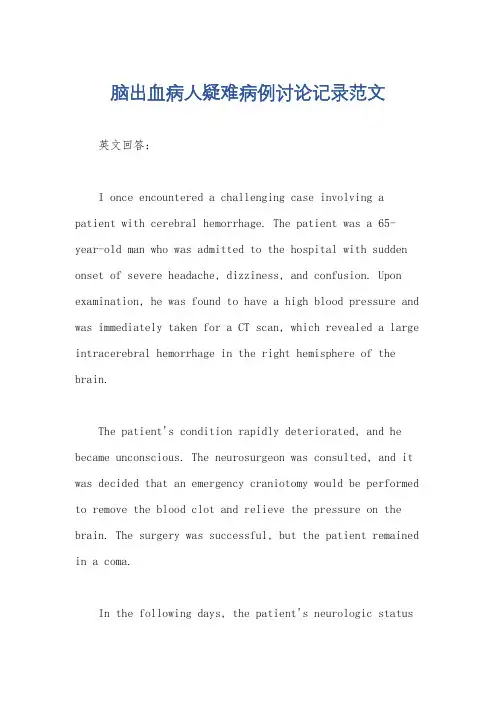
脑出血病人疑难病例讨论记录范文英文回答:I once encountered a challenging case involving a patient with cerebral hemorrhage. The patient was a 65-year-old man who was admitted to the hospital with sudden onset of severe headache, dizziness, and confusion. Upon examination, he was found to have a high blood pressure and was immediately taken for a CT scan, which revealed a large intracerebral hemorrhage in the right hemisphere of the brain.The patient's condition rapidly deteriorated, and he became unconscious. The neurosurgeon was consulted, and it was decided that an emergency craniotomy would be performed to remove the blood clot and relieve the pressure on the brain. The surgery was successful, but the patient remained in a coma.In the following days, the patient's neurologic statusdid not improve. He had difficulty breathing and required mechanical ventilation. Despite aggressive medical management, his condition continued to worsen. The family was informed about the poor prognosis and the possibility of withdrawing life support.As a nurse, I was involved in the care of this patient and witnessed the emotional toll it took on his family. They were torn between wanting to do everything possible to save him and the realization that his chances of recovery were slim. It was a difficult decision for them to make, but ultimately they decided to withdraw life support and allow him to pass away peacefully.中文回答:我曾经遇到过一例困难的脑出血病人。

脑干出血疑难病例讨论记录范文病例名称:脑干出血疑难病例讨论病例编号:XXXXXX讨论时间:2023年10月15日讨论地点:神经外科会议室参与人员:神经外科全体医生、护士长及护理团队病例简介:患者,男,45岁,因“突发意识丧失、呕吐、四肢无力”入院。
患者家属诉,患者于早晨起床时突然出现意识丧失,伴有呕吐,四肢无力,无法自主呼吸,立即拨打120送往我院。
既往病史:患者有长期高血压病史,未经正规治疗。
否认其他疾病史。
检查结果:1. 颅脑CT:显示脑干出血,出血量约10ml,血肿周围水肿明显。
2. 磁共振成像(MRI):显示脑干出血灶,周围脑组织水肿。
3. 动脉血气分析:低氧血症,二氧化碳潴留。
4. 心电图:正常。
5. 血液检查:血常规、凝血功能、血糖、血脂等指标异常。
病例分析:1. 诊断:根据患者的临床表现、颅脑CT和MRI结果,诊断为脑干出血。
2. 病因:患者长期高血压,未经治疗,导致脑干血管破裂出血。
3. 病情评估:患者病情危重,意识丧失,四肢无力,呼吸困难,生命体征不稳定。
脑干出血量较大,周围脑组织水肿明显,病情进展迅速。
治疗方案:1. 立即进行气管插管,机械通气,维持呼吸功能。
2. 给予降血压、抗脑水肿、护脑等药物治疗。
3. 准备进行脑干血肿清除术,减轻脑水肿,防止脑疝。
4. 严密监测患者生命体征,及时处理并发症。
讨论内容:1. 病因及危险因素:脑干出血的病因多种多样,本例患者主要为长期高血压所致。
高血压是脑出血的最常见病因,患者未经治疗,血压控制不佳,导致脑干血管破裂出血。
2. 病情评估与救治:脑干出血病情危重,患者出现意识丧失、呼吸困难等症状,需要立即进行救治。
本例患者在入院后,立即进行气管插管、机械通气,并给予降血压、抗脑水肿、护脑等药物治疗。
同时,准备进行脑干血肿清除术,减轻脑水肿,防止脑疝。
3. 手术治疗:脑干出血手术治疗的风险较大,手术难度高。
本例患者出血量较大,周围脑组织水肿明显,手术治疗的必要性较大。
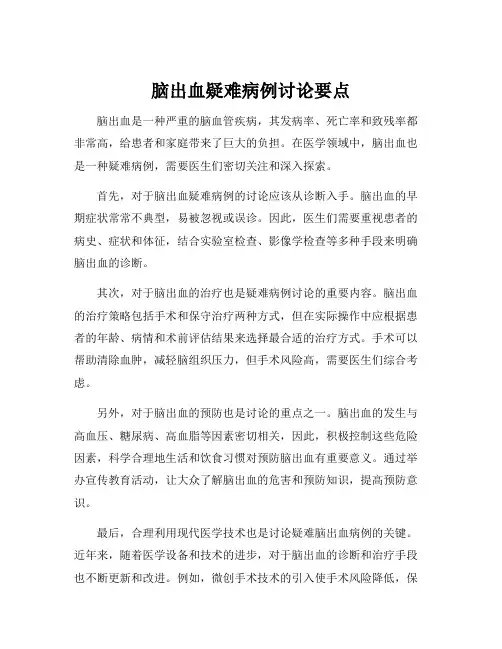
脑出血疑难病例讨论要点脑出血是一种严重的脑血管疾病,其发病率、死亡率和致残率都非常高,给患者和家庭带来了巨大的负担。
在医学领域中,脑出血也是一种疑难病例,需要医生们密切关注和深入探索。
首先,对于脑出血疑难病例的讨论应该从诊断入手。
脑出血的早期症状常常不典型,易被忽视或误诊。
因此,医生们需要重视患者的病史、症状和体征,结合实验室检查、影像学检查等多种手段来明确脑出血的诊断。
其次,对于脑出血的治疗也是疑难病例讨论的重要内容。
脑出血的治疗策略包括手术和保守治疗两种方式,但在实际操作中应根据患者的年龄、病情和术前评估结果来选择最合适的治疗方式。
手术可以帮助清除血肿,减轻脑组织压力,但手术风险高,需要医生们综合考虑。
另外,对于脑出血的预防也是讨论的重点之一。
脑出血的发生与高血压、糖尿病、高血脂等因素密切相关,因此,积极控制这些危险因素,科学合理地生活和饮食习惯对预防脑出血有重要意义。
通过举办宣传教育活动,让大众了解脑出血的危害和预防知识,提高预防意识。
最后,合理利用现代医学技术也是讨论疑难脑出血病例的关键。
近年来,随着医学设备和技术的进步,对于脑出血的诊断和治疗手段也不断更新和改进。
例如,微创手术技术的引入使手术风险降低,保守治疗的药物疗效也得到了提高。
因此,医生们应该及时关注和应用新的医学技术,提高脑出血治疗的水平。
综上所述,脑出血疑难病例的讨论需要从诊断、治疗和预防等各个方面全面分析和探讨。
医生们要重视患者的病情和个体差异,科学合理地选择治疗方法,并结合最新的技术和研究成果指导临床实践。
同时,提高大众对脑出血的预防意识,加强教育宣传,对于减少脑出血的发生具有重要意义。



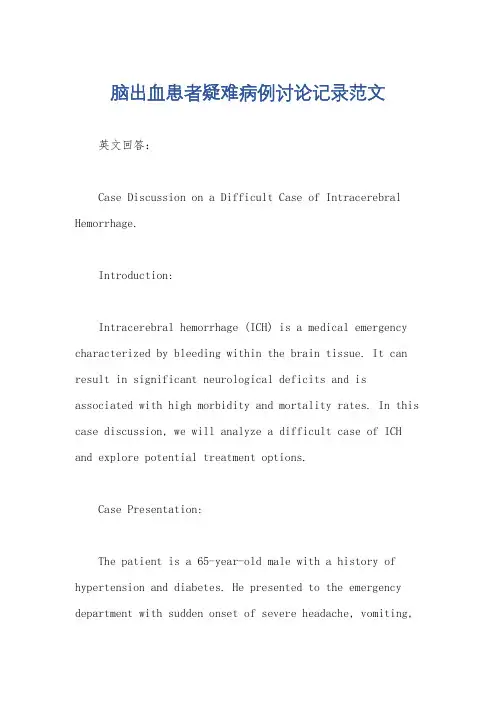
脑出血患者疑难病例讨论记录范文英文回答:Case Discussion on a Difficult Case of Intracerebral Hemorrhage.Introduction:Intracerebral hemorrhage (ICH) is a medical emergency characterized by bleeding within the brain tissue. It can result in significant neurological deficits and is associated with high morbidity and mortality rates. In this case discussion, we will analyze a difficult case of ICH and explore potential treatment options.Case Presentation:The patient is a 65-year-old male with a history of hypertension and diabetes. He presented to the emergency department with sudden onset of severe headache, vomiting,and right-sided weakness. A computed tomography (CT) scan revealed a large ICH in the left basal ganglia region.English Answer:Treatment Options:1. Medical Management:Blood pressure control: Aggressive blood pressure control is essential to prevent further bleeding and reduce the risk of hematoma expansion. Intravenous antihypertensive medications such as nicardipine or labetalol can be used.Intracranial pressure control: Elevated intracranial pressure can worsen the patient's condition. Measures such as head elevation, sedation, and osmotic diuretics (e.g., mannitol) can be employed.Seizure prophylaxis: ICH can increase the risk of seizures. Antiepileptic drugs like phenytoin orlevetiracetam can be prescribed.Blood sugar control: Given the patient's history of diabetes, maintaining strict blood sugar control is crucial to prevent complications.2. Surgical Intervention:Decompressive craniectomy: In cases of significant mass effect and impending herniation, a decompressive craniectomy can be considered to relieve intracranial pressure.Hematoma evacuation: Surgical removal of the hematoma may be necessary in selected cases, especially if there is evidence of ongoing bleeding or significant mass effect.3. Rehabilitation:Physical therapy: Once the patient is stable, a comprehensive rehabilitation program should be initiated tooptimize functional recovery and improve quality of life.Speech therapy: If the patient experiences speech difficulties or swallowing problems, speech therapy can be beneficial.Occupational therapy: Occupational therapy can help the patient regain independence in activities of daily living.中文回答:治疗选择:1. 医学管理:控制血压,积极控制血压是预防进一步出血和减少血肿扩大风险的关键。
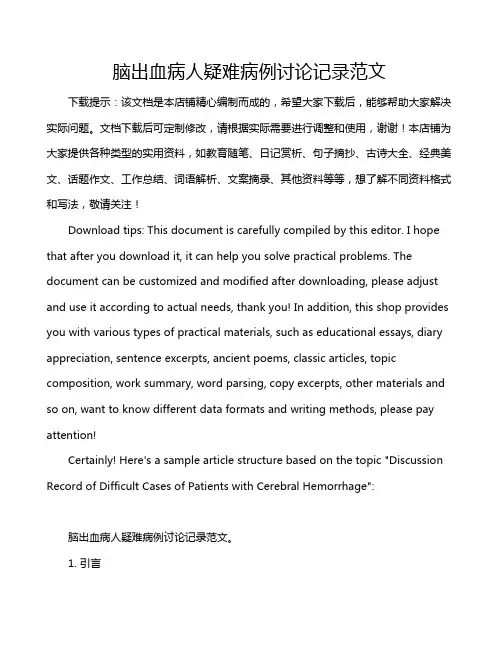
脑出血病人疑难病例讨论记录范文下载提示:该文档是本店铺精心编制而成的,希望大家下载后,能够帮助大家解决实际问题。
文档下载后可定制修改,请根据实际需要进行调整和使用,谢谢!本店铺为大家提供各种类型的实用资料,如教育随笔、日记赏析、句子摘抄、古诗大全、经典美文、话题作文、工作总结、词语解析、文案摘录、其他资料等等,想了解不同资料格式和写法,敬请关注!Download tips: This document is carefully compiled by this editor. I hope that after you download it, it can help you solve practical problems. The document can be customized and modified after downloading, please adjust and use it according to actual needs, thank you! In addition, this shop provides you with various types of practical materials, such as educational essays, diary appreciation, sentence excerpts, ancient poems, classic articles, topic composition, work summary, word parsing, copy excerpts, other materials and so on, want to know different data formats and writing methods, please pay attention!Certainly! Here's a sample article structure based on the topic "Discussion Record of Difficult Cases of Patients with Cerebral Hemorrhage":脑出血病人疑难病例讨论记录范文。
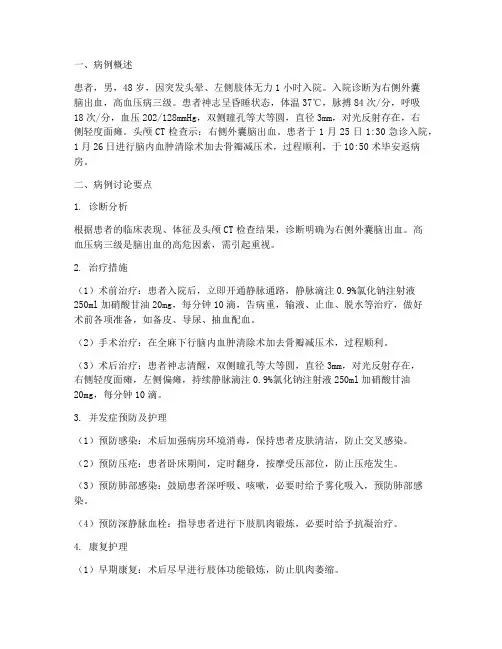
一、病例概述患者,男,48岁,因突发头晕、左侧肢体无力1小时入院。
入院诊断为右侧外囊脑出血,高血压病三级。
患者神志呈昏睡状态,体温37℃,脉搏84次/分,呼吸18次/分,血压202/128mmHg,双侧瞳孔等大等圆,直径3mm,对光反射存在,右侧轻度面瘫。
头颅CT检查示:右侧外囊脑出血。
患者于1月25日1:30急诊入院,1月26日进行脑内血肿清除术加去骨瓣减压术,过程顺利,于10:50术毕安返病房。
二、病例讨论要点1. 诊断分析根据患者的临床表现、体征及头颅CT检查结果,诊断明确为右侧外囊脑出血。
高血压病三级是脑出血的高危因素,需引起重视。
2. 治疗措施(1)术前治疗:患者入院后,立即开通静脉通路,静脉滴注0.9%氯化钠注射液250ml加硝酸甘油20mg,每分钟10滴,告病重,输液、止血、脱水等治疗,做好术前各项准备,如备皮、导尿、抽血配血。
(2)手术治疗:在全麻下行脑内血肿清除术加去骨瓣减压术,过程顺利。
(3)术后治疗:患者神志清醒,双侧瞳孔等大等圆,直径3mm,对光反射存在,右侧轻度面瘫,左侧偏瘫,持续静脉滴注0.9%氯化钠注射液250ml加硝酸甘油20mg,每分钟10滴。
3. 并发症预防及护理(1)预防感染:术后加强病房环境消毒,保持患者皮肤清洁,防止交叉感染。
(2)预防压疮:患者卧床期间,定时翻身,按摩受压部位,防止压疮发生。
(3)预防肺部感染:鼓励患者深呼吸、咳嗽,必要时给予雾化吸入,预防肺部感染。
(4)预防深静脉血栓:指导患者进行下肢肌肉锻炼,必要时给予抗凝治疗。
4. 康复护理(1)早期康复:术后尽早进行肢体功能锻炼,防止肌肉萎缩。
(2)心理护理:关心患者情绪,加强心理疏导,帮助患者树立战胜疾病的信心。
三、讨论总结本次病例讨论,我们针对患者病情进行了全面分析,明确了诊断及治疗方案。
在治疗过程中,加强并发症预防及护理,确保患者安全。
同时,注重康复护理,提高患者生活质量。
通过本次病例讨论,我们提高了对脑出血的诊疗水平,为今后类似病例的诊疗提供了参考。
脑出血死亡病历讨论记录范文英文版Discussion Record of a Cerebral Hemorrhage Death CaseBackground:On [Insert Date], a 58-year-old male patient with a history of hypertension presented to the emergency department with sudden onset of severe headache, vomiting, and loss of consciousness. Upon arrival, the patient was found to be in a coma with a Glasgow Coma Scale (GCS) score of 8. Initial computed tomography (CT) scan of the brain revealed a large intracerebral hemorrhage in the left parietal region.Treatment:The patient was immediately admitted to the intensive care unit (ICU) for management. Intravenous (IV) mannitol was given to reduce intracranial pressure, and the patient was started on a ventilator to assist with breathing. Conservative managementwas planned with close monitoring of the patient's neurological status and serial CT scans to assess the hematoma's progression.Course of Disease:Over the next 24 hours, the patient's condition worsened. He developed bilateral pupillary dilation and decerebrate posturing. Repeated CT scans showed no significant change in the size of the hematoma. Despite aggressive management, the patient did not respond to treatment.Cause of Death:On the second day of admission, the patient succumbed to the hemorrhage due to severe brain damage. The cause of death was attributed to the massive intracerebral hemorrhage.Discussion:The case was discussed among the medical team to identify potential areas of improvement in patient management. It was noted that early surgical intervention might have been beneficial in this case, considering the large size of the hematoma and the patient's deteriorating condition. There wasalso a consensus among the team to improve patient education on the importance of regular follow-up and strict control of hypertension to prevent such complications.Conclusion:This case highlights the importance of prompt diagnosis and aggressive management of intracerebral hemorrhage. Future cases should be evaluated for surgical intervention early to prevent further brain damage and improve outcomes.中文版脑出血死亡病历讨论记录范文背景:[插入日期],一名有高血压病史的58岁男性患者突然出现严重头痛、呕吐和意识丧失,被送至急诊科。
脑出血护理危重病例讨论记录引言本次病例讨论记录旨在深入探讨脑出血患者的护理管理,特别是对于危重病例的处理策略。
通过集思广益,共同探讨,以期提高脑出血患者的护理质量和治疗效果。
病例背景患者,男性,60岁。
因脑出血入院,伴有肢体活动障碍和意识障碍。
经过初步诊断和评估,确认为脑出血后遗症,属于危重病例。
现需制定科学合理的护理计划。
讨论内容1. 专业团队的协作:针对该危重病例,需要形成跨学科的护理团队,包括神经外科医师、神经内科医师、护士、物理治疗师等,以共同制定和实施护理计划。
2. 病情观察与监测:密切监测患者生命体征,包括血压、心率、呼吸,以及神经功能状态的观察,如瞳孔反应、肢体活动情况等。
3. 液体管理:根据患者的血压情况和液体平衡,调整输液速度和种类,保持患者的血流动力学稳定。
4. 伤口和导管的护理:定期检查患者伤口和各种导管(如尿管、导尿管等),保持其通畅和清洁,及时更换敷料。
5. 营养支持:根据患者的营养状态和需要,制定个性化的营养支持计划,包括通过管路给予营养支持,或者考虑经口摄入。
6. 疼痛管理:根据患者的疼痛程度和个体特点,给予相应的疼痛管理措施,如及时给予镇痛药物、物理疗法等。
7. 并发症的预防与处理:预防和处理可能出现的并发症,如感染、血栓形成、肺炎等。
及时进行预防性抗生素治疗和适当的预防性抗凝治疗。
结论通过本次病例讨论,我们明确了脑出血危重病例的护理重点和策略。
建立跨学科的护理团队,密切监测患者的病情变化,实施科学合理的护理措施,有助于提高脑出血患者的生存率和康复率。
同时,我们也强调了并发症的预防和处理的重要性,以减少患者的不良后果。
本文档仅为讨论记录,具体护理计划需根据具体病情和医疗团队的建议制定,不可作为直接实施的依据。
护理病例讨论范文一、病例介绍患者,男,45岁,因“突发右侧肢体活动障碍2小时”入院。
患者于入院前2小时在活动中突然出现右侧肢体无力,伴言语不清,就诊于当地医院,行头颅CT 检查提示“右侧基底节区脑出血”,为进一步治疗收入院。
患者既往有高血压病史10年,最高血压180/100mmHg,规律服用降压药物,血压控制可。
否认糖尿病、心脏病、传染病史。
二、护理评估1. 身体状况:患者意识清楚,精神萎靡,右侧肢体肌力1级,左侧肢体肌力正常。
右侧巴氏征阳性,左侧巴氏征阴性。
2. 心理状态:患者及家属对病情较为担忧,存在焦虑、恐惧情绪。
3. 生活护理:患者生活能够自理,但右侧肢体活动受限,需协助完成日常活动。
4. 社交状况:患者社交正常,家庭关系融洽。
三、护理诊断1. 急性脑出血后遗症:右侧肢体活动障碍、言语不清。
2. 焦虑、恐惧情绪:与病情及预后担忧有关。
3. 生活自理能力下降:与右侧肢体活动受限有关。
四、护理计划1. 急性脑出血后遗症护理:(1)保持病房环境安静、舒适,避免刺激。
(2)保持患者呼吸道通畅,观察呼吸、脉搏、血压等生命体征。
(3)做好基础护理,保持皮肤清洁、干燥,预防压疮。
(4)协助患者进行康复锻炼,如坐起、穿衣、进食等,逐渐提高生活自理能力。
2. 心理护理:(1)与患者及家属建立良好的沟通,倾听他们的需求和顾虑。
(2)给予耐心、细致的解答,帮助患者及家属了解病情及治疗方案。
(3)鼓励患者及家属积极参与治疗,增强信心。
3. 生活护理:(1)协助患者完成日常活动,如洗漱、进食、翻身等。
(2)指导患者进行适当的康复锻炼,提高生活质量。
(3)加强家属护理知识培训,提高家庭护理能力。
五、护理实施1. 急性脑出血后遗症护理:(1)保持病房环境安静、舒适,调整床位角度,使患者舒适。
(2)观察患者生命体征,及时报告异常情况。
(3)保持患者皮肤清洁、干燥,预防压疮。
(4)协助患者进行康复锻炼,逐步提高生活自理能力。
脑出血病例讨论引言脑出血是一种严重的神经系统疾病,通常由于脑血管破裂导致大脑组织内出血。
它是一种急性疾病,病情严重,常常导致残疾甚至死亡。
本文将通过讨论一个脑出血病例,探讨脑出血的病因、临床表现、诊断和治疗等方面的内容。
病例描述患者是一名55岁的男性,平时身体健康,无明显的高血压、糖尿病等慢性疾病。
突然出现剧烈头痛、恶心、呕吐等症状,家人立即将其送往医院就诊。
在医院急诊科接受检查后,病人被诊断为脑出血。
病因脑出血的病因有多种可能,包括高血压、动脉瘤、血液疾病、头部创伤等。
对于这位患者,初步诊断认为是高血压引起的脑出血。
高血压会导致脑动脉壁的损伤和动脉硬化,增加了脑血管破裂的风险。
临床表现脑出血的临床表现因患者个体差异而有所不同,但常见的症状包括剧烈头痛、呕吐、意识障碍、肢体瘫痪等。
这位患者的主要症状是剧烈头痛和呕吐,这两个症状提示脑出血的可能性。
诊断脑出血的诊断通常通过临床症状、神经影像学检查和脑脊液检查等综合手段进行。
对于这位患者,医生首先进行了头部CT扫描,发现了脑出血的存在。
进一步的脑脊液检查和血液检查有助于确定病因和评估病情。
治疗脑出血的治疗主要包括手术和药物治疗。
手术可以通过去除血肿、修复血管等方式来减轻脑组织的损伤。
药物治疗主要是通过降低脑压、控制高血压等手段来改善病情。
对于这位患者,他接受了紧急手术来清除脑出血并修复血管。
预后脑出血的预后取决于多个因素,包括患者的年龄、病情严重程度、治疗及康复情况等。
对于这位患者,他在手术后经过密切监护和积极的康复治疗,病情逐渐好转。
然而,脑出血后遗症仍然存在,需要长期的康复和护理。
结论脑出血是一种严重的疾病,病情危重,治疗和康复过程都需要密切监护和专业的护理。
通过讨论这个脑出血病例,我们可以更好地了解脑出血的病因、临床表现、诊断和治疗等方面的知识。
同时,我们也应该重视高血压等慢性疾病的预防和控制,以减少脑出血的发生风险。